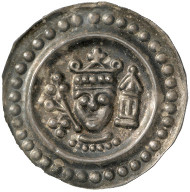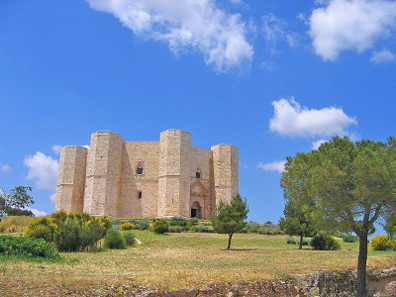courtesy of the MoneyMuseum, Zurich
translated by Teresa Teklic
Why is it that for centuries – or rather thousands of years – the head has served as the motif for the side of a coin? And why has this changed in the last 200 years? Ursula Kampmann poses these questions in her book ‘MenschenGesichter,’ from which the texts for our series are taken.
Holy Roman Empire. Frederick II, of the House of Hohenstaufen, King of Sicily (1197-1250), Holy Roman Emperor (after 1220). Pfennig, royal mint Ulm. Royal bust with crown and sceptre, petal branch to the left, tower to the right. © MoneyMuseum, Zurich.
It’s the year 1212. The people of Constance are waiting for their emperor. Otto IV, excommunicated ruler over the Holy Roman Empire, is camping with his followers in Überlingen to prepare for his festive entry into the city. But what is that? An armed regiment approaches and requests admittance. “Who are you?” may have been the city guard’s question – “The Emperor and his followers!” the men’s reply. The guards open the gates and young Frederick II, elected anti-emperor only weeks before, marches into Constance. Otto IV, who arrives at the city three hours later, is left standing. He is forced to leave the city on an empty stomach while Frederick and his company relish the banquet prepared by the people of Constance for their emperor.
none
Castel del Monte is Frederick’s most impressive edifice. It is situated in the region Apulia and visible from a great distance. Photo: Guido Radig / http://creativecommons.org/licenses/by/3.0/deed.de
Of course Frederick hadn’t won the Holy Roman Empire yet, but as far as the boy from Apulia was concerned – his enemies often referred to the just 18 year-old with that name – Fortuna was on his side. And her assistance was certainly needed because Frederick was unable to strike a military victory over Otto with the 300 men who marched with him into the Holy Roman Empire. So he decided to rely on other means: diplomacy, persuasion and seduction. The dukes and counts, the city councils and the clergy all shared a weakness for money – and Frederick took advantage of that. He gave them heaps of silver. When he was elected Holy Roman Emperor on December 5, 1212, he distributed the enormous sum of 20,000 marks of silver among his followers. Soon all of the empire’s tribes stood united behind their new emperor.
Otto’s enemies from abroad took care of the rest. Philip Augustus, the King of France, defeated Frederick’s rival in the Battle of Bouvines. As a sign of his loyalty, Philip Augustus sent Frederick Otto’s imperial standard, torn into pieces.
In July 1215 Frederick was crowned Holy Roman Emperor in Aachen. Otto was forced to flee to the neighbouring city Cologne, hiding under a pilgrim’s garb. He died three years later, on May 19, 1218, in his residence in Brunswick. It is said that he ordered priests to scourge him on his deathbed to earn God’s forgiveness. The miserable death of the once great Otto freed the way for the boy from Apulia. Now he could become “Stupor Mundi”, the “astonishment of the world”.
Next time we will tell the story of Henry VI of England and how the War of Roses took its beginning with him.
All sections of the series can be found here.
The book ‘MenschenGesichter’ is available in printed form from the Conzett Verlag website. It soon will be translated to English …







